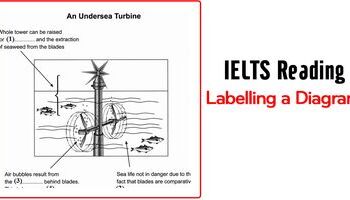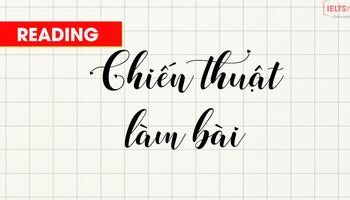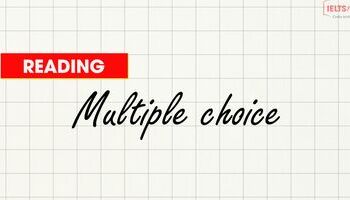Labelling a diagram hay còn được gọi là Completing diarams, là dạng bài đưa ra một quy trình, một bản vẽ kĩ thuật hoặc một thiết kế của một loại máy móc nào đó. Trong một diagram sẽ có các từ khóa để gợi ý cho các bạn và cũng có các ô trống câu hỏi.
Cùng xem video nha:
Format IELTS Reading - Labelling a diagram
Câu hỏi IELTS Reading dạng này sẽ có 3 loại biểu đồ: thể hiện quá trình phát triển của một hiện tượng thiên nhiên, bản vẽ kỹ thuật hay biểu đồ thiết kế hoặc một kế hoạch.
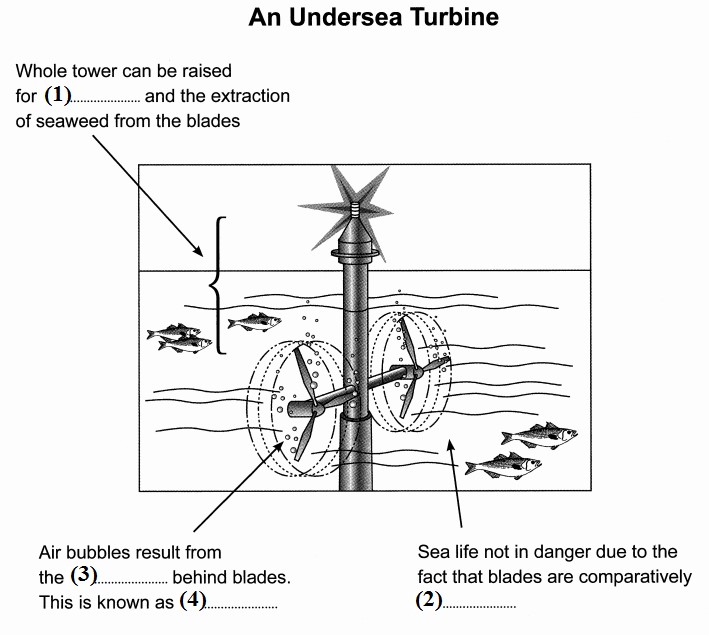
Các bước làm bài Completing diarams
Bước 1. Đọc thật kỹ yêu cầu đề bài
Ví dụ:
Đề bài yêu cầu “NO MORE THAN TWO WORDS AND/OR A NUMBER from the text”
Như các dạng câu hỏi trước chúng ta đã học, hãy lưu ý kỹ :
- NO MORE THAN TWO WORDS AND/OR A NUMBERnghĩa là number = one word
Cùng điểm lại, một số cũng được tính là 1 từ. Trong đó ví dụ như 23 June hay June 23 vẫn là 1 số + 1 từ hay ngược lại một từ + một số. June 23 cũng là đáp án cho trường hợp yêu cầu one word and/or a number.
Với trường hợp, March 31st, 1972 là 3 words and/or numbers vì “st” không tính.
Trường hợp đề bài yêu cầu chỉ one word and/or a number đáp án sẽ là 31 March.
Với mạo từ cũng được tính là 1 từ ví dụ như a book – 2 từ.
Những từ có dấu gạch ngang như out-of-date (hết hạn) cũng sẽ tính là 1 từ.
- … FROM THE TEXT
Với cụm từ nay, có nghĩa là:
+, Đáp án chỉ được sử dụng những từ lấy ra từ bài đọc thôi
+, Bạn không được phép thay đổi từ vựng, form, paraphrase hay synonyms đều không được chấp nhận.
Nhưng nếu không có cụm từ này thì có nghĩa là bạn có thể dùng những từ đồng nghĩa hoặc cụm từ tương đương khác miễn sao nghĩa vẫn đúng, lưu ý chỉ trong giới hạn số từ được dùng thôi nhé.
Bước 2: Gạch chân từ khóa
trong câu hỏi và đưa ra dự đoán
Keywords (Từ khóa) trong Reading sẽ có 2 dạng từ khóa: Changeable keywords và Unchangeable Keywords.
- Changeable keywords là từ khóa có thể biến đổi được trong bài đọc. Là những Từ có khả năng bị paraphrase hoặc (Cụm) Danh từ, động từ, tính từ…
- Unchangeable keywords là từ khóa không bị biến đổi, ví dụ như: tên riêng, tên khoa học, con số, dữ liệu, ngày tháng…
Ví dụ:
1. Whole tower can be raised for (1).................. and extraction of seaweed from the blades
2. Sea life not in danger due to the fact that blades are comparatively (2).......................
Từ khóa trong câu 1: tower, raised, seaweed from the blades à Dự đoán từ cần tiền là noun. Vì sau đó là “and extraction”, extraction là noun nên từ đằng trước cũng phải là dạng tương đương.
Từ khóa trong câu 2: Sea life, not in danger, blades à Dự đoán từ cần tiền là adj. Vì trước đó là trạng từ comparatively và cần 1 tính từ để bổ nghĩa cho danh từ “the blades”.
Bước 3: Tìm từ khóa
trong bài đọc
Bài đọc:
D. A marine turbine blade needs to be only one-third of the size of a wind generator to produce three times as much power. The blades will be about 20 metres in diameter so around 30 metres of water is required. Unlike wind power, there are unlikely to be environmental objections. Fish and other creatures are thought unlikely to be at risk from the relatively slow-turning blades. Each turbine will be mounted on a tower which will connect to the national power supply grid via underwater cables. The towers will stick out of the water and be lit to warn shipping, and also be designed to be lifted out of the water for maintenance and to clean seaweed from the blades.
Từ khóa: Fish and other creatures, unlikely to be at risk, lifted out of the water
Từ khóa bị paraphrase:
Fish and other creatures = sea life
unlikely to be at risk = not in danger
lifted out of the water = raised
Bước 4: Chọn đáp án đúng
1. Whole tower can be raised for (1).................. and extraction of seaweed from the blades
Toàn bộ tháp có thể được nâng lên (1) .................. và chiết rong biển từ các cánh quạt.
Bài đọc:
The towers will stick out of the water and be lit to warn shipping, and also be designed to be lifted out of the water for maintenance and to clean seaweed from the blades. (Các tòa tháp sẽ nhô lên mặt nước và được thắp sáng để cảnh báo cho tàu thuyền, và cũng được thiết kế để nhấc lên khỏi mặt nước để bảo trì và làm sạch rong biển từ cánh quạt.)
Câu trả lời cần tìm là 1 danh từ, mà lifted out of the water for = raised for
-> Đáp án là maintainance
2. Sea life not in danger due to the fact that blades are comparatively (2).......................
Sinh vật biển sẽ không gặp nguy hiểm do thực tế là cánh quạt tương đối là (2) .......................
Bài đọc:
Fish and other creatures are thought unlikely to be at risk from the relatively slow-turning blades. (Cá và các sinh vật khác được cho là không bị nguy hiểm vì các cánh quạt quay tương đối chậm.)
Câu trả lời cần tìm là một tính từ, mà Fish and other creatures = sea life
unlikely to be at risk = not in danger
-> Đáp án là slow-turning
Bước 5. Check lại ngữ pháp và chính tả
1. Whole tower can be raised for maintainance and extraction of seaweed from the blades
2. Sea life not in danger due to the fact that blades are comparatively slow-turning.
Hãy nhớ khi trích từ vựng từ bài đọc ra chúng ta phải luôn check lỗi chính tả, số ít/số nhiều, danh từ hay tính từ, và ngữ pháp xem có đúng hay không. Và lưu ý cuối cùng là check số lượng từ điền vào đã phù hợp với giới hạn từ trong đề bài hay chưa.
Lưu ý những vấn đề thường gặp phải
Khi làm bài, các bạn quá tập trung vào biểu đồ và cố gắng hiểu hết biểu đồ được cho. Nên những biểu đồ không quen thuộc có khiến làm bạn lo lắng. Nhưng đừng quá chú trọng bởi bài thi không đánh giá kiến thức về kĩ thuật của bạn mà đang đánh giá kĩ năng đọc hiểu của bạn. Do đó, bạn cần hiểu ý chính, mối quan hệ của biểu đồ và bài đọc là được.
Không xác định được đoạn văn có câu trả lời mà đi đọc toàn bài, mất thời gian không cần thiết.
Check- up 1
Water Treatment 2 : Reed Bed
[…] A vertical flow (downflow) reed bed is a sealed, gravel filled trench with reeds growing in it. The reeds in a downflow system are planted in a bed 60cm deep. In vertical flow reed beds, the wastewater is applied to the top of the reed bed, flows down through a rhizome zone with sludge as a substrate, then through a root zone with sand as a substrate, followed by a layer of gravel for drainage, and is collected in an under drainage system of large stones. The effluent flows onto the surface of the bed and percolates slowly through the different layers into an outlet pipe, which leads to a horizontal flow bed where it is cleaned by millions of bacteria, algae, fungi, and microorganisms that digest the waste, including sewage. There is no standing water so there should be no unpleasant smells.
Vertical flow reed bed systems are much more effective than horizontal flow reed- beds not only in reducing biochemical oxygen demanded (BOD) and suspended solids (SS) levels but also in reducing ammonia levels and eliminating smells. Usually considerably smaller than horizontal flow beds, they are capable of handling much stronger effluents which contain heavily polluted matters and have a longer lifetime value. A vertical reed bed system works more efficiently than a horizontal reed bed system, but it requires more management, and its reed beds are often operated for a few days then rested, so several beds and a distribution system are needed. […]
Questions 17-19
Complete the diagram below.
Choose NO MORE THAN THREE WORDS from the passage for each answer.
Downflow Reed Bed System

Các mẹo làm bài Labelling a diagram
Mẹo 1: Câu trả lời không luôn luôn xếp theo thứ tự như các đoạn văn.
Phân tích ví dụ sau:
Thông tin: Dung beetles work from the inside of the pat so they are sheltered from predators such as birds and foxes. Most species burrow into the soil and bury dung in tunnels directly underneath the pats, which are hollowed out from within. Some large species originating from France excavate tunnels to a depth of approximately 30 cm below the dung pat. These beetles make sausage-shaped brood chambers along the tunnels. The shallowest tunnels belong to a much smaller Spanish species that buries dung in chambers that hang like fruit from the branches of a pear tree. South African beetles dig narrow tunnels of approximately 20 cm below the surface of the pat. Some surface-dwelling beetles, including a South African species, cut perfectly-shaped balls from the pat, which are rolled away and attached to the bases of plants.
Label the tunnels on the diagram below using words from the box.
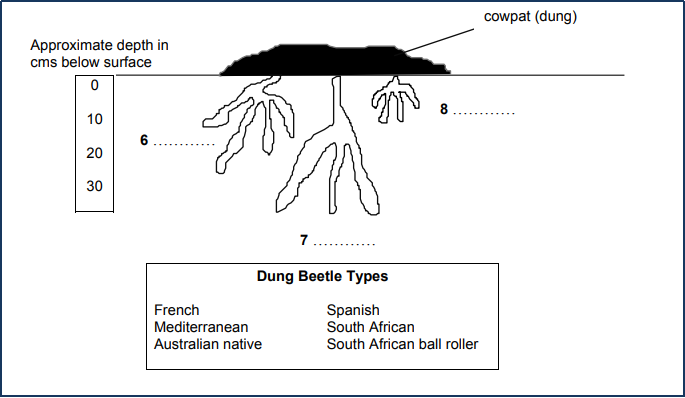
Đáp án:
6. South African
7. French
8. Spanish
Có thể thấy rằng thứ tự xuất hiện các đáp án không tương ứng với thứ tự xuất hiện thông tin trong đoạn văn.
Mẹo 2: Làm những câu hỏi đơn giản nhất trước. Bạn có nhiều khả năng để có được những câu trả lời chính xác. Nếu bạn không thể tìm thấy câu trả lời cho một câu hỏi khó, chuyển qua câu khác và quay lại sau.
Bạn có nhiều khả năng để có được những câu trả lời chính xác. Nếu bạn không thể tìm thấy câu trả lời cho một câu hỏi khó, chuyển qua câu khác và quay lại sau.
Với mẹo này, sẽ giúp bạn tiết kiệm được nhiều thời gian làm bài và không bỏ lỡ điểm cho các câu hỏi đơn giản.
Mẹo 3: Cố gắng để dự đoán câu trả lời trước khi bạn đọc các văn bản. Điều này sẽ giúp bạn trong việc tìm câu trả lời chính xác.
Việc dự đoán câu trả lời trước khi đọc sẽ giúp kích thích tư duy của thí sinh, giúp nhớ câu hỏi nhanh hơn và tìm ra thông tin chính xác hơn.
Check- up 2
[…] D. A marine turbine blade needs to be only one-third of the size of a wind generator to produce three times as much power. The blades will be about 20 metres in diameter so around 30 metres of water is required. Unlike wind power, there are unlikely to be environmental objections. Fish and other creatures are thought unlikely to be at risk from the relatively slow turning blades. Each turbine will be mounted on a tower which will connect to the national power supply grid via underwater cables. The towers will stick out of the water and be lit to warn shipping, and also be designed to be lifted out of the water for maintenance and to clean seaweed from the blades.
E. Dr Bahaj has done most work on the Alderney site, where there are powerful currents. The single undersea turbine farm would produce far more power than needed for the Channel Islands and most would be fed into the French Grid and be re-imported into Britain via the cable under the Channel.
F. One technical difficulty is cavitation, where low pressure behind a turning blade causes air bubbles. These can cause vibration and damage the blades of the turbines. Dr Bahaj said: ‘We have to test a number of blade types to avoid this happening or at least make sure it does not damage the turbines or reduce performance. Another slight concern is submerged debris floating into the blades. So far we do not know how much of a problem it might be. We will have to make the turbines robust because the sea is a hostile environment. but all the signs that we can do it are good.
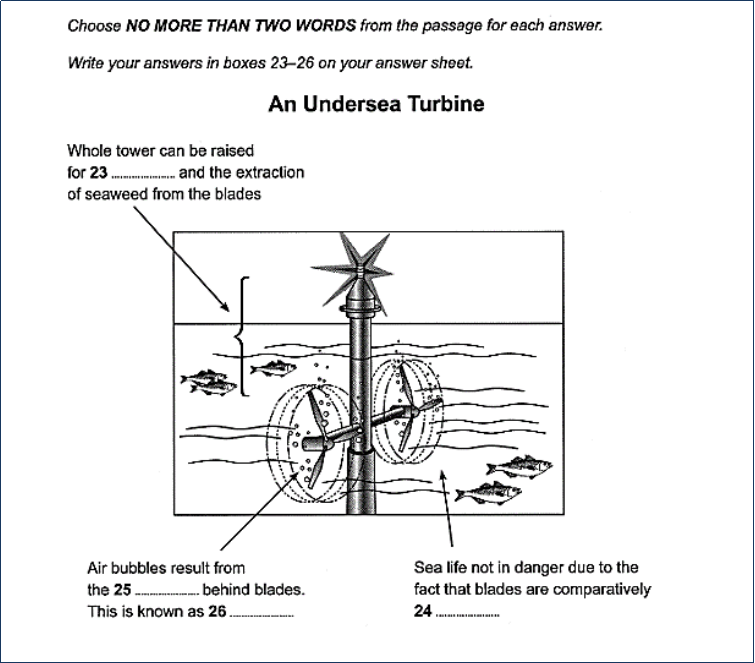
Luyện tập có đáp án
PASSAGE 1
Simple Chemical Experiments
Hydrogen can be made very easily by using simple laboratory equipment. All you need is a thistle funnel, cork, glass dish, graduated glass cylinder, test tube, glass pipe, zinc, tap water, and hydrochloric acid. To begin with, 5ml of tap water is put into a 50ml graduated glass cylinder with about 1gm of zinc. The top of the glass cylinder is fitted with a cork and a thistle funnel and a glass pipe inserted into it. The glass pipe connects the cylinder with a glass dish. Sufficient tap water is placed in the dish to cover the top of the pipe which is then covered with a water filled test tube. Before adding 5 ml of hydrochloric acid to the funnel it is important to make sure that the end of the funnel is below the tap water. Once added, the hydrochloric acid comes into contact with the tap water very quickly and an immediate chemical reaction can be seen. Hydrogen gas is released and starts to travel down the pipe into the test tube. The hydrogen displaces the water and produces a test tube of pure hydrogen gas. By adding baking soda to the cylinder the acid solution is neutralized and can be poured down the sink.
Questions 1 – 8
The diagram below shows how hydrogen can be made using simple laboratory equipment.
Label the diagram.
Choose NO MORE THAN THREE WORDS from the passage for each answer.
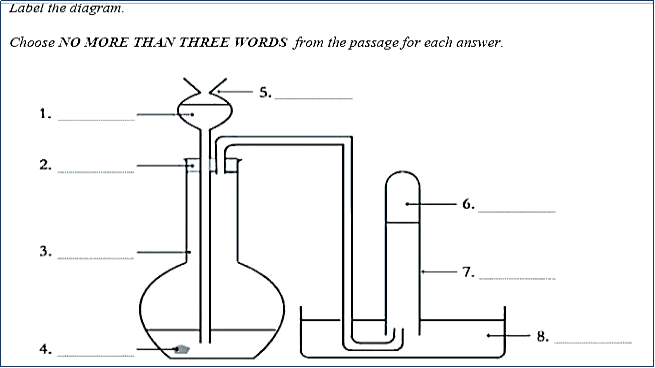
Đáp án
Check-up 1
(Từ câu 17 – 19, các đáp án nằm ở đoạn văn thứ 6 của bài)
17. Đáp án: sludge
18. Đáp án: sand
19. Đáp án: gravel
Theo hình vẽ, chúng ta dò được thông tin trong câu văn sau “In vertical flow reed beds, the wastewater is applied to the top of the reed bed, flows down through a rhizome zone with sludge as a substrate, then through a root zone with sand as a substrate, followed by a layer of gravel for drainage, and is collected in an under drainage system of large stones”.
Check-up 2
23. cần 1 danh từ, gạch chân tower/ seaweed from the blade+ cần 1 mục đích cho việc raise the tower → Đoạn D 2 dòng cuối: lifted out of water= raised→ maintenance
24. cần 1 tính từ mô tả cho từ blades, gạch chân sealife/ not in danger/ blades → Đoạn D dòng 4: sealife= fish and other creatures/ not in danger= unlikely to be at risk→ slow-turning
25. cần 1 danh từ, gạch chân air bubbles/ behind blades + cần 1 cái gì đằng sau blades gây ra air bubbles (result from) → đoạn F dòng 1, từ cause= result in >< result from → low pressure
26. cần 1 cái tên. Gạch chân known as → đoạn F dòng 1, one technical difficulty is cativation where low pressure behind turning blade causes air bubbles → cavitation.
PASSAGE 1
1. 5ml hydrochloric acid
2. cork
3. 50ml graduated cylinder / 50ml glass cylinder
4. 1gm of zinc
5. thistle funnel
6. hydrogen gas
7. test tube
8. tap water
Thế là chúng ta đã hoàn thành dạng bài Completing diagram hay Labelling a diagram trong IELTS Reading rồi, các bạn nhớ áp dụng các bước làm bài hiệu quả nhé.
Xem thêm các dạng bài khác:
IELTS Reading: Chiến lược làm bài SENTENCE COMPLETION
IELTS Reading: Chiến lược làm bài SHORT ANSWER QUESTION
Bài phân tích đề thi thật, thực hiện bởi IELTS Fighter, vui lòng ghi nguồn nếu sử dụng chia sẻ. Xin cảm ơn.
